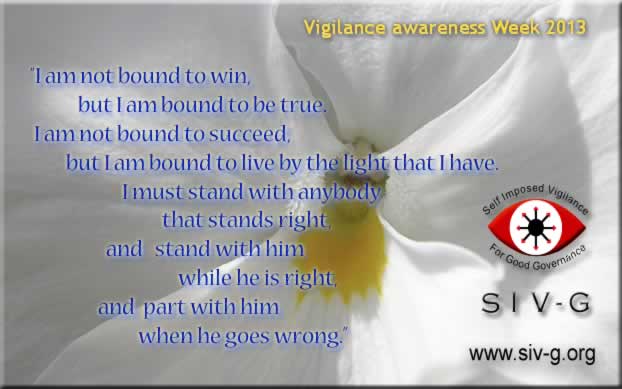“Strength and growth come only through continuous effort and struggle”, says a famous quote of Napoleon Hill. Strengthening the Vigilance Machinery in India is not an exception to this saying. The continuous effort and struggle for the Vigilance Machinery in India to evolve over the decades is evident from the setting up of Central Vigilance Commission (CVC) in 1964 on the recommendation of Santhanam Committee to the present level of Vigilance framework available in India. Nevertheless, the scope for strengthening the Vigilance Machinery further always remains particularly with the exponential growth of all pervasive corruption. It was Justice Santhosh Hegde, who mentioned in one of his Lectures few years back that in olden days, people used to count the number corrupt persons but in today’s context, we are now counting the number of honest persons! This is a clear reflection of the extent of corruption pervaded in all walks of life and the need arises for weeding out corruption from India, which is the theme of VSC Souvenir, 2018.
There are two important areas, where the Vigilance framework in India needs to be strengthened:
(i)Strengthening Vigilance mechanism in Ministries / Departments of Union of India
It is after a great struggle with sustained efforts by the CVC that today we have in important Ministries/Departments a full time Chief Vigilance Officer (CVO). There were times when a part-time CVO used to be in- charge of many Departments. Then a time came when all Ministries had a part-time CVO and now we have full time CVOs in important Ministries/Department. Things have changed a lot for good, but still it is a long way to go.
Even with the full time CVOs in important Ministries, what is apparently missing is a structured Vigilance set-up with adequate manpower to support the CVOs of the Ministries. While the DPE came out with a Model Vigilance Structure for Public Sector Enterprises (PSEs) in 1998, based on which many PSEs established a full-fledged Vigilance set-up, a similar Model Vigilance Structure for the Ministries are still to be evolved. This is more important because of the important role envisaged on the CVOs of Ministries.
CVOs of the Ministry are mandated with a dual role to perform viz, (i) as CVO of the Ministry and its attached offices (for their own Vigilance Administration) and (ii) as CVO for the Board level executives of the PSEs under the respective Ministry. Given the fact that each Ministry has a good number PSEs under their administrative control, all the Board level executives of those PSEs fall under the jurisdiction of CVOs of Ministry. The work load (not in terms of numbers but in terms of sensitivity and implications) in handling the vigilance cases of those Board level executives becomes onerous. This is in addition to their primary role of Vigilance Administration of the respective Ministry and attached offices. These arduous tasks entrusted to the CVOs of the Ministry indeed warrant an elaborate Vigilance set-up with adequate manpower at their disposal for effective functioning.
Perhaps, it is high time that CVC comes out with a Model Vigilance Structure for the Ministries similar to the Model Vigilance Structure put in place as per DPE guidelines of 1998 for PSEs.
(ii)Strengthening Vigilance mechanism in State Government Departments
Corruption in any society is measured based on the impact it makes on common man in his day to day life. Thus, it is perceived that corruption in local administration hits the common man directly, starting from Panchayat level to district level and on to State level. When a common man complains of corruption, most of the time he refers to corruption in local administration particularly those departments dealing with food supply (PDS), water, electricity, driving licence, roads, hospitals etc. All those departments catering to these requirements of common man are under the purview of State governments. Sadly, the country’s apex anti-corruption body (i.e. CVC) does not have any jurisdiction over these departments! To make things worse, these State Government Departments neither have a structured Vigilance set-up nor a regular CVO (full or part time), unlike the Central Government Ministries. The situation is not different when it comes to State Vigilance Commission. This is yet another challenge!
Again, CVC may take the lead and initiate steps through the State Vigilance Commissions to create Vigilance structure for the State government departments.
Ultimately, there is no one giant step which could weed out corruption from India. It is a lot of little steps that could help in that direction. The two steps as discussed above, if examined and implemented, will go a long way in weeding out corruption from India.

